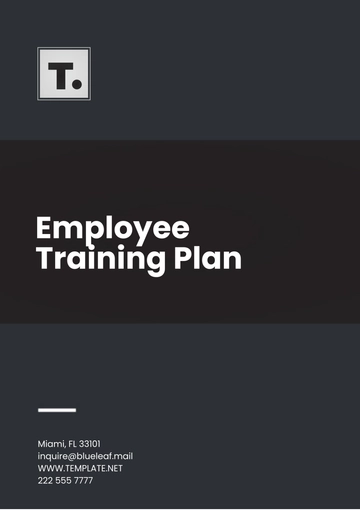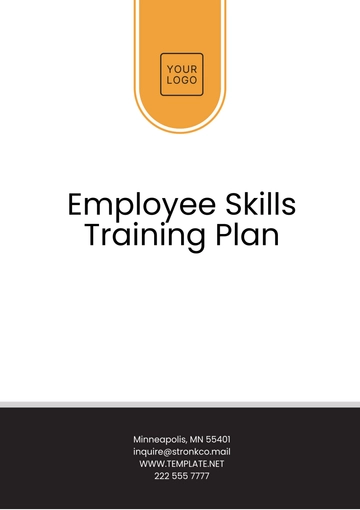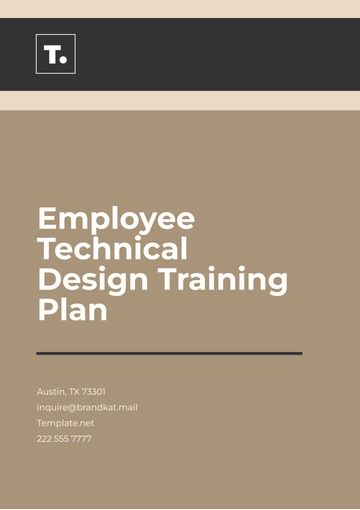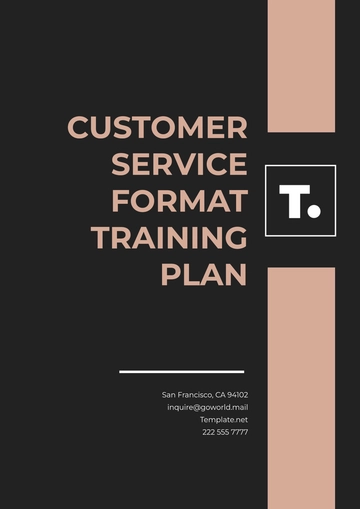Free Health and Wellness Employee Training Plan

I. Introduction
This plan aims to enhance employee health and wellness by providing a structured training program that addresses physical, mental, and social well-being. With a focus on creating a supportive and inclusive environment, the program is designed to promote a healthier lifestyle, improve productivity, and reduce stress, ultimately fostering a positive work culture.
II. Objectives
Improve overall health and wellness of employees.
Reduce workplace stress and improve mental health.
Enhance productivity, job satisfaction, and employee retention.
Promote a positive and inclusive work environment.
Encourage a culture of proactive health and wellness.
III. Training Modules
A. Physical Wellness
This module focuses on promoting physical health through regular exercise, proper nutrition, and preventive care.
Exercise Programs: Weekly fitness sessions guided by certified trainers, offering a variety of activities like yoga, Pilates, cardio, and strength training.
Nutrition Education: Workshops on balanced diets, meal planning, and maintaining a healthy weight.
Preventive Health Screenings: Regular health check-ups, vaccination programs, and health risk assessments to prevent illnesses.
B. Mental Wellness
This module aims to enhance mental well-being by providing resources for stress management, resilience building, and mindfulness practices.
Stress Management: Training on coping mechanisms, relaxation techniques, and time management skills.
Resilience Building: Interactive sessions on resilience, adaptability, and managing workplace challenges.
Mindfulness Practices: Guided meditation sessions, mindfulness workshops, and access to mental health resources, including counseling.
C. Social Wellness
This module emphasizes building a supportive community within the workplace and fostering positive relationships.
Team-Building Activities: Group activities such as team sports, retreats, and social events to foster camaraderie.
Communication Skills: Workshops on effective communication, conflict resolution, and empathy.
Community Engagement: Opportunities for volunteer work, community service, and environmental initiatives.
IV. Implementation Timeline
Phase | Activity | Timeline |
|---|---|---|
Phase 1 | Program Design and Planning | Month 1 |
Phase 2 | Employee Orientation and Enrollment | Month 2 |
Phase 3 | Training Implementation | Month 3 - Month 12 |
Phase 4 | Assessment and Feedback | End of Month 12 |
V. Budget Allocation
A budget will be allocated to cover trainer fees, wellness resources, venue costs, and materials. An estimated budget breakdown is provided to ensure transparency and allow for the effective allocation of resources.
Trainer Fees: Allocation for certified trainers in fitness, mental health, and nutrition experts.
Wellness Resources: Budget for meditation apps, wellness kits, and other resources.
Event and Venue Costs: Costs for retreats, team-building events, and other physical wellness activities.
Program Materials: Handouts, digital resources, and access to online wellness platforms.
VI. Program Accessibility and Inclusion
To ensure every employee benefits from this program, we commit to making it accessible and inclusive:
Flexible Scheduling: Multiple time slots and online options will be provided to accommodate various shifts and remote employees.
Inclusive Content: Program materials will consider diverse dietary needs, fitness levels, and cultural backgrounds.
Feedback from Underrepresented Groups: Collect feedback to continuously adapt the program to meet diverse needs and make adjustments based on feedback from various employee groups.
VII. Long-term Strategy and Sustainability
This program is part of a long-term strategy to embed health and wellness into the company culture. Efforts to sustain the program will include:
Annual Review and Adaptation: Regularly updating the training modules based on trends in wellness and employee feedback.
Wellness Champions: Establishing a wellness committee or designating wellness ambassadors to encourage participation.
Continuous Learning Opportunities: Expanding the program by offering courses on topics like financial wellness, sleep hygiene, and chronic condition management.
VIII. Evaluation and Feedback
Employee feedback will be collected at the end of the program to assess its effectiveness and areas for improvement. Evaluation methods will include:
Surveys: Online surveys to gather anonymous feedback on the program’s impact.
Focus Groups: Small group discussions to delve into specific experiences and suggestions for improvement.
Personal Interviews: One-on-one interviews with a sample of employees for in-depth feedback on mental, physical, and social well-being.
IX. Conclusion
The Health and Wellness Employee Training Plan aims to foster a holistic approach to employee well-being, creating a healthier and more productive workplace. This program is designed to support employees in achieving a balanced and fulfilling work-life experience, strengthening the organization’s commitment to their well-being and continuous growth.
- 100% Customizable, free editor
- Access 1 Million+ Templates, photo’s & graphics
- Download or share as a template
- Click and replace photos, graphics, text, backgrounds
- Resize, crop, AI write & more
- Access advanced editor
Elevate employee well-being with Template.net’s Health and Wellness Employee Training Plan Template. This fully customizable, editable template is designed to streamline training programs for healthier workplaces. Easily tailored to your needs and editable in our Ai Editor Tool, it’s the perfect solution for creating impactful health and wellness plans that inspire and support your team.
You may also like
- Finance Plan
- Construction Plan
- Sales Plan
- Development Plan
- Career Plan
- Budget Plan
- HR Plan
- Education Plan
- Transition Plan
- Work Plan
- Training Plan
- Communication Plan
- Operation Plan
- Health And Safety Plan
- Strategy Plan
- Professional Development Plan
- Advertising Plan
- Risk Management Plan
- Restaurant Plan
- School Plan
- Nursing Home Patient Care Plan
- Nursing Care Plan
- Plan Event
- Startup Plan
- Social Media Plan
- Staffing Plan
- Annual Plan
- Content Plan
- Payment Plan
- Implementation Plan
- Hotel Plan
- Workout Plan
- Accounting Plan
- Campaign Plan
- Essay Plan
- 30 60 90 Day Plan
- Research Plan
- Recruitment Plan
- 90 Day Plan
- Quarterly Plan
- Emergency Plan
- 5 Year Plan
- Gym Plan
- Personal Plan
- IT and Software Plan
- Treatment Plan
- Real Estate Plan
- Law Firm Plan
- Healthcare Plan
- Improvement Plan
- Media Plan
- 5 Year Business Plan
- Learning Plan
- Marketing Campaign Plan
- Travel Agency Plan
- Cleaning Services Plan
- Interior Design Plan
- Performance Plan
- PR Plan
- Birth Plan
- Life Plan
- SEO Plan
- Disaster Recovery Plan
- Continuity Plan
- Launch Plan
- Legal Plan
- Behavior Plan
- Performance Improvement Plan
- Salon Plan
- Security Plan
- Security Management Plan
- Employee Development Plan
- Quality Plan
- Service Improvement Plan
- Growth Plan
- Incident Response Plan
- Basketball Plan
- Emergency Action Plan
- Product Launch Plan
- Spa Plan
- Employee Training Plan
- Data Analysis Plan
- Employee Action Plan
- Territory Plan
- Audit Plan
- Classroom Plan
- Activity Plan
- Parenting Plan
- Care Plan
- Project Execution Plan
- Exercise Plan
- Internship Plan
- Software Development Plan
- Continuous Improvement Plan
- Leave Plan
- 90 Day Sales Plan
- Advertising Agency Plan
- Employee Transition Plan
- Smart Action Plan
- Workplace Safety Plan
- Behavior Change Plan
- Contingency Plan
- Continuity of Operations Plan
- Health Plan
- Quality Control Plan
- Self Plan
- Sports Development Plan
- Change Management Plan
- Ecommerce Plan
- Personal Financial Plan
- Process Improvement Plan
- 30-60-90 Day Sales Plan
- Crisis Management Plan
- Engagement Plan
- Execution Plan
- Pandemic Plan
- Quality Assurance Plan
- Service Continuity Plan
- Agile Project Plan
- Fundraising Plan
- Job Transition Plan
- Asset Maintenance Plan
- Maintenance Plan
- Software Test Plan
- Staff Training and Development Plan
- 3 Year Plan
- Brand Activation Plan
- Release Plan
- Resource Plan
- Risk Mitigation Plan
- Teacher Plan
- 30 60 90 Day Plan for New Manager
- Food Safety Plan
- Food Truck Plan
- Hiring Plan
- Quality Management Plan
- Wellness Plan
- Behavior Intervention Plan
- Bonus Plan
- Investment Plan
- Maternity Leave Plan
- Pandemic Response Plan
- Succession Planning
- Coaching Plan
- Configuration Management Plan
- Remote Work Plan
- Self Care Plan
- Teaching Plan
- 100-Day Plan
- HACCP Plan
- Student Plan
- Sustainability Plan
- 30 60 90 Day Plan for Interview
- Access Plan
- Site Specific Safety Plan
























